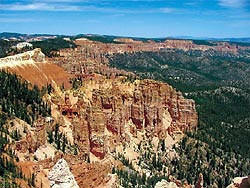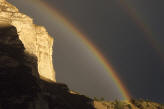 We
encourage our visitors to start their auto tour of Bryce Canyon National
Park by driving directly to the very southern end first. From here at
Rainbow Point the entirety of the park stretches out before you back to
the north. We
encourage our visitors to start their auto tour of Bryce Canyon National
Park by driving directly to the very southern end first. From here at
Rainbow Point the entirety of the park stretches out before you back to
the north.Before you leave the Rainbow
Point area make sure you walk to the southern overlook — Yovimpa Point.
Here is one of the places you can get a good look at the sequence of rock
layers called the
Grand
Staircase. The sections or steps in the Grand Staircase are named for
the dominant color of rock. You are standing on the top step known as the
Pink Cliffs. Directly below you are the Grey Cliffs. As you look into the
distance you can see Molly's Nipple which is part of the White Cliffs.
Looking down into distant canyons near the horizon, you can just make out
some red rock underneath the White Cliffs. This red rock makes up the
Vermilion Cliffs. Hidden from view but directly under the Towering
Vermilion cliffs are the comparatively diminutive, Chocolate Cliffs. The
tree-covered hills that meet the horizon belong to the Kaibab Plateau —
the North Rim of the Grand Canyon.
Spending a few minutes at both Rainbow and
Yovimpa Point provides visitors with a geologic and geographic
orientation, helping them better understand the landscape, and landforms
that surround Bryce Canyon National Park and thereby better appreciate the
unique beauty of this National Park.
Geology
From Rainbow Point, visitors can look northward and clearly see the Pink
Cliffs out of which the Hoodoos have been sculpted. The cliffs curve
around amphitheaters carved by the headward erosion of small streams and
tributaries to the Paria River in times of flow. The entire Pink Cliffs of
Bryce are but a single step in the much larger
Grand Staircase.
As first described by the geographer Clarence Dutton in 1870s the Grand
Staircase is so large that from any one vantage point most of it is hidden
behind the curvature of the Earth. Yovimpa Point offers visitors a chance
to see a large portion of the Grand Staircase.
Nature
This is the highest elevation of the park exceeding 9100 ft. Here the
forest is dominated by Blue Spruce, Douglas-fir and White Fir. This kind
of forest makes good habitat for grouse, woodpeckers, owls, and a variety
of squirrels and chipmunks. Here you are also sure to see Ravens and
Steller's Jays. Get used to them, because you are going to find them
everywhere in the park. These bird species are important reminders to the
fact that although many plants and animals are limited to certain types of
habitat, other kinds can range though several different habitats.
Trails
The Riggs Spring Loop
Trail, is a strenuous backcountry trail, that plunges into the canyons
below Yovimpa Point, completing a 7.5 mile loop between Rainbow and
Yovimpa Point. To the north, the rest of our backcountry trail system
called the Under-the-Rim trail stretches 23 miles, eventually returning to
the canyon rim at Bryce Point. Overnight travel in Bryce Canyon's
Backcountry requires a permit which can only be obtained at the Visitor
Center.
The much easier, .8 mile
Bristlecone Loop
meanders through the forest atop this highest portion of the park. Here
you will pass by
Bristlecone Pines up to 1,800-years-old.
Services
Restrooms & emergency phone
|

